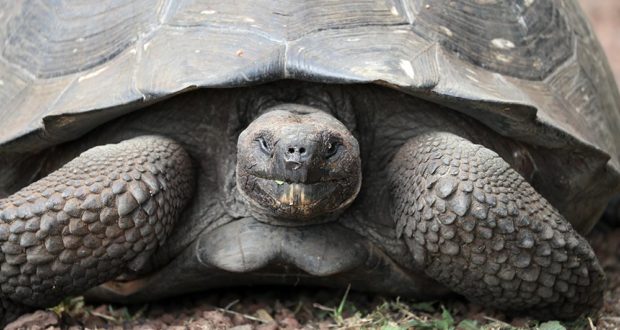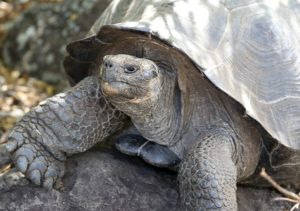As I was walking along I met two large tortoises, each of which must have weighed a least two hundred pounds: one was eating a piece of cactus, and as I approached, it stared at me and slowly walked away; the other gave a deep hiss, and drew in its head.
Charles Darwin, 15 September 1835
On most of the islands, the prospects of walking along casually and meeting a Galapagos giant tortoise are relatively slim. Once numbering the the hundreds of thousands, there are perhaps 20,000 left today. My only encounters with these poster children for the Galapagos came in wild tortoise preserves and private ranches on San Cristobal and Santa Cruz.
Even in the preserves, it is arresting to see one lumber into view, emerging from the brush, wallowing in a muddy watering hole or munching on grass at the edge of a forest. Some are truly massive, with enormous, meaty paws that move them along with the deliberate power of a bulldozer. Their necks are surprisingly long, their weary but sagacious faces clothed in armor plate and the experience of several lifetimes.
The largest I encountered had a shell more than four feet long; the smallest – except for those in the hatchery – was about a foot. Mature giant tortoises weigh more than 500 pounds. Their lifespan is uncertain, but pegged at more than 150 years. Certainly some of them today were youngsters when Darwin published his On the Origin of Species.
The problem for the tortoises early on was that they are apparently fairly tasty. Darwin observed in his Voyage of the Beagle that while hiking in the highlands, he and his colleagues “lived entirely upon tortoise-meat: the breast-plate roasted (as the Gauchos do carne con cuero), with the flesh on it, is very good; and the young tortoises make excellent soup.” For centuries, whalers and other seafaring men loaded them on their ships by the hundreds. Because they were able to go for long periods without food or water, living tortoises were an excellent way to store meat for long voyages. More recently, they fell prey to feral dogs and pigs and goats that literally ate away their habitat. From a population of as much as 250,000, they dwindled to a low of 3,000, but conservation efforts have prompted a rebound.
There are about 14 species of giant tortoise among the Galapagos Islands, but they fall into two broad categories. Those with rounded dome shells are generally found on islands with moist highlands, where vegetation is plentiful and the tortoises graze easily on the ground. Those with saddleback shells that turn upward at the front are generally from the more arid islands, where the tortoises have to reach up into the branches of cactus. The tortoises I saw on San Cristobal (G. chatamensis?) had a saddleback shell, while most of those on Santa Cruz (G. nigrita) were domed, though there were a couple – probably recruited from another island – that had a deep saddleback.
The tortoises I crossed paths with were either resting, tearing on foliage or trudging cross-country. In any case, they paid little attention to me. Only if I approached them suddenly or unexpectedly did they withdraw into their shells and let out a long hiss. One of my colleagues observed a pair mating – confirming they do everything slowly and deliberately and, according to Darwin in his Voyage of the Beagle, loudly:
During the breeding season, when the male and female are together, the male utters a hoarse roar or bellowing, which, it is said, can be heard at the distance of more than 100 yards.
It’s hard to imagine how these behemoths got to the Galapagos. They certainly didn’t swim. Among the speculation is that eggs or smallish tortoises arrived on the rafts of vegetation that often follow a storm. In the absence of predators, they lived longer, grew larger and spread throughout the islands.


